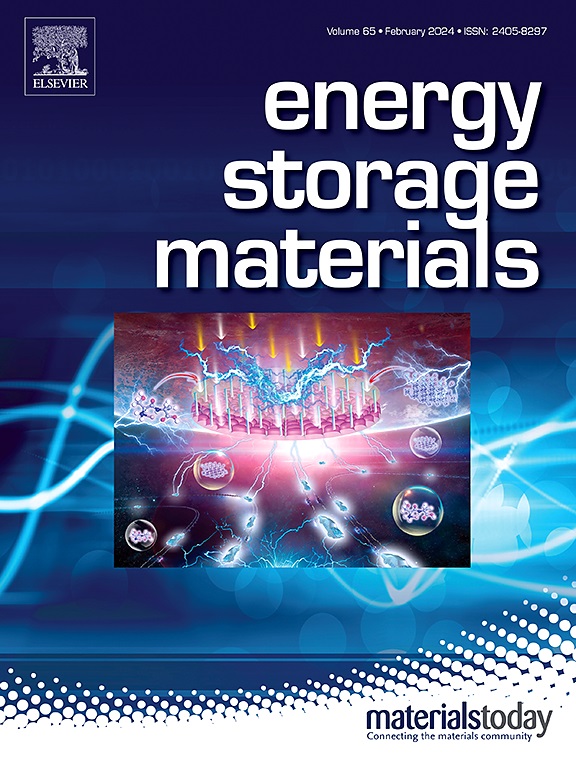Co-continuous hard Carbon/NASICON electrodes for all-solid-state batteries: Insights into structural stability and interfacial Na-ion transfer
IF 20.2
1区 材料科学
Q1 CHEMISTRY, PHYSICAL
引用次数: 0
Abstract
Sodium-ion batteries (SIBs) have recently been launched as alternatives to lithium-ion batteries (LIBs). Since the superiority of SIBs over LIBs lies in the abundance and low cost of raw materials, SIBs are expected to be deployed in large-scale storage systems, where long-term stable operation with a high level of safety is demanded rather than high energy density. On this account, all-solid-state sodium-ion batteries (ASS-SIBs) comprising an air-stable oxide solid electrolyte are of great promise but still in their infancy. In this study, we focus on hard carbon, which is first in line for SIB anodes, in conjunction with a NASICON-type solid electrolyte, Na3Zr2Si2PO12 (NZSP), and elucidate the underlying electrode capability of hard carbon for ASS-SIBs. Monolithic NZSP/carbon electrode layers with an elaborately designed co-continuous microstructure have been fabricated via the sol–gel technique to exploit the potential of hard carbon. Consequently, the favorable performance of hard carbon in the NZSP-based ASS cell is validated: a reversible capacity of >300 mAh g–1, an initial coulombic efficiency of 94 %, and a stable cycling over 500 cycles. The striking longevity underpins a minuscule volume change of carbon during sodiation/desodiation. The kinetic study on the interfacial Na+-transfer highlights the lower activation energy (∼0.4 eV) at NZSP/carbon interface than that in a liquid electrolyte. All the findings in this study clearly corroborate the significant potential in the combination of hard carbon anodes and NASICON-type solid electrolytes for ASS-SIBs.


用于全固态电池的共连续硬碳/NASICON电极:结构稳定性和界面na离子转移的见解
钠离子电池(SIBs)最近作为锂离子电池(lib)的替代品推出。由于sib相对于lib的优势在于原材料丰富且成本低,因此sib有望部署在大型存储系统中,而不是高能量密度,需要长期稳定运行且具有高安全性。因此,包含空气稳定氧化物固体电解质的全固态钠离子电池(ASS-SIBs)具有很大的前景,但仍处于起步阶段。在这项研究中,我们将重点放在硬碳上,它是SIB阳极的首选,与nasicon型固体电解质Na3Zr2Si2PO12 (NZSP)结合,并阐明硬碳用于ass -SIB的潜在电极性能。利用溶胶-凝胶技术开发了具有精心设计的共连续结构的单片NZSP/碳电极层,以开发硬碳的潜力。因此,硬碳在基于nzsp的ASS电池中的良好性能得到了验证:300 mAh g-1的可逆容量,94%的初始库仑效率,以及超过500次循环的稳定循环。惊人的寿命支撑了在钠化/脱钠过程中碳的微小体积变化。界面Na+转移的动力学研究表明,与液体电解质相比,在NZSP/碳界面上Na+转移的活化能(~ 0.4 eV)较低。本研究的所有发现都清楚地证实了硬碳阳极和nasicon型固体电解质结合用于ass - sib的巨大潜力。
本文章由计算机程序翻译,如有差异,请以英文原文为准。
求助全文
约1分钟内获得全文
求助全文
来源期刊

Energy Storage Materials
Materials Science-General Materials Science
CiteScore
33.00
自引率
5.90%
发文量
652
审稿时长
27 days
期刊介绍:
Energy Storage Materials is a global interdisciplinary journal dedicated to sharing scientific and technological advancements in materials and devices for advanced energy storage and related energy conversion, such as in metal-O2 batteries. The journal features comprehensive research articles, including full papers and short communications, as well as authoritative feature articles and reviews by leading experts in the field.
Energy Storage Materials covers a wide range of topics, including the synthesis, fabrication, structure, properties, performance, and technological applications of energy storage materials. Additionally, the journal explores strategies, policies, and developments in the field of energy storage materials and devices for sustainable energy.
Published papers are selected based on their scientific and technological significance, their ability to provide valuable new knowledge, and their relevance to the international research community.
 求助内容:
求助内容: 应助结果提醒方式:
应助结果提醒方式:


